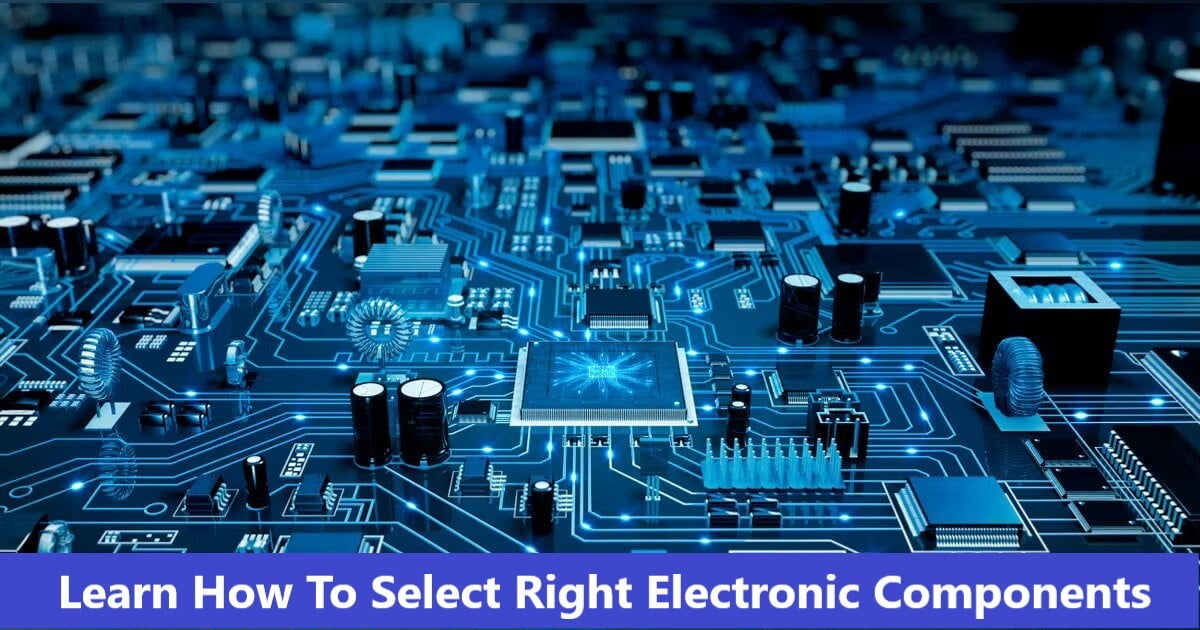
In the fast-evolving development of electronics, choosing the right components is a crucial thing that can make your project. Whether you're an Embedded engineer or a hobbyist, understanding the electronic components is essential. Choosing the right electronic components for your project can make a big difference in its performance, reliability, and cost. But how do you decide which ones to use among the many options available? In this article, you will learn some of the best practices for selecting electronic components based on your design goals, specifications, and budget.
To start with, We recommend making a list of electronic components and their critical parameters which need to be used. There are a number of parameters which we at Campus Component always consider while choosing and providing the right electronic component for you.
Important Factors to Consider While Selecting Electronic Components
In this article, we provide some of the steps which you can follow :
Define Your Project Requirements
Research Available Components
Compare Components
Check Compatibility
Reliability and Quality
Electrical Parameters
Mechanical Parameters
Consider Future Needs
Test and Verify
Define Your Project Requirements:
Clearly outline your project's functionality, performance expectations, size constraints, and power requirements.
Develop a comprehensive understanding of the technical specifications that will drive your component selection process.
Conduct In-Depth Research on Available Components:
Explore the market for components that align with your project's requirements.
Look for components with a proven track record of reliability, widespread usage, and robust documentation and support.
Thoroughly Compare Components:
Evaluate components based on their unique features, cost implications, availability, and other relevant factors.
Consider trade-offs such as the balance between performance and cost or the relationship between power consumption and size.
Ensure Compatibility:
Verify that the selected components are not only compatible with each other but also with the chosen platform for your project.
Avoid potential integration challenges by confirming compatibility from the outset.
Reliability and Quality:
Reliability and quality of electronic components is important when selecting electronic components.
When selecting components you should select them from reputable manufacturers and distributors to ensure the quality and authenticity of the components.
Investing in high-quality components may incur higher initial costs, but the long-term benefits in terms of reliability and performance are worth it.
Electrical Parameters (Voltage, Current, Power, Accuracy, Response Time, Speed, Resolution):
This is the most important factor to consider when choosing the electronic components, Eg: for a MOSFET, you need to see its breakdown voltage, channel, Load, Drain to source voltage(VDS) etc.
When considering a DC-DC Converter IC, some of the electrical parameters would be input voltage range, output voltage accuracy, inbuilt protections available like over current, over voltage, under voltage cutoff, thermal shutdown, light load efficiency, power rating, thermal management, etc.
Nuvoton Microcontroller you need to see its voltage, current, temperature and frequency.
Make sure you make a list so that you do not miss a critical parameter.
Mechanical Parameters (Dimension, Package, Weight):
Mechanical parameters are a critical factor in component selection when considering the size constraints for your application.
Size Constraints Consideration:
Determine whether a slightly larger size is acceptable or if a compact package is necessary.
Smaller packages may increase assembly, testing, and repair complexities.
SMD Resistor Selection:
When selecting an SMD resistor, the difficulty of manual soldering varies between packages (e.g., 0402, 0603, or 0805).
Smaller packages like 0402 pose challenges in manual soldering compared to larger counterparts.
Lead-Less Packages (BGA / LLP) Consideration:
Lead-less packages like BGA or LLP add complexity to PCB design and manual soldering.
Carefully decide whether automated PCB assembly or manual soldering aligns better with your requirements.
Overall Weight Impact:
Keeping the overall product weight low is advisable.
Low weight directly influences shipping costs.
Weight Consideration Examples:
Weight is a significant constraint for certain products, such as wearables or items used on drones.
Evaluate the impact of weight on constraints specific to your application.
For example: Mornsun Power Supply - In this you need to check the package, dimension, weight of the product as per your project requirements. Because package, dimension are also the important factors while designing pcb for applications.
Consider Future Project Needs:
Plan for future developments by selecting components that allow for upgrades or additional integrations.
Select components that provide flexibility and easy integration into your project's evolving requirements.
Test and Verify Component :
Employ appropriate testing tools and techniques to verify that the chosen components seamlessly work together as intended.
Confirm that the components meet the specific project requirements through rigorous testing.
Some Other Important Factors
1. Performance Requirements:
Evaluate voltage and current requirements, frequency specifications, accuracy, and precision to ensure optimal performance.
2. Form Factor:
Take into account the physical size and shape of the components to align with the project's form factor requirements.
3. Power Consumption:
Assess operating voltage, power rating, and efficiency to understand the power consumption of the selected components.
Conclusion
All these factors should be considered when selecting electronic components for embedded systems or your electronic application. The goal is to ensure that the components you choose are the best fit for your project's requirements. You can minimize the risks of delays, errors, and other issues which occur during the development and deployment phases. By following the above steps, you can select the right components for your project and we hope your project becomes successful.
